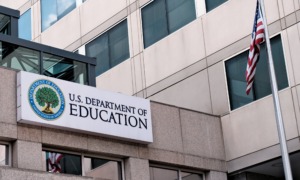
ThaiPrayBoy/Shutterstock
.
America’s justice system is reverting to 1960s-style “law-and-order” policies that are exacting a heavy toll on communities of color, especially young people, according to a report released today by a national anti-poverty group.
“Unjustice: Overcoming Trump’s Rollbacks on Youth Justice” documents how the Trump administration’s Department of Justice is curtailing key advancements and protections for young people of color. The nation’s top law enforcement agency is instituting “malicious” federal policies that target young people of color, according to the report, from the Center for Law and Social Policy (CLASP).
Those policies, along with a steady drumbeat of hateful speech, xenophobia and misleading crime data, as well as racial profiling, harassment and violence by police, has created a national mood of fear and distrust, the report concluded.

Kisha Bird
Kisha Bird, one of the authors of the report and CLASP director of youth policy, called the findings “an alarm for us to continue to pay attention.
“The criminal and juvenile justice reform had been bipartisan in the recent past and we not only want that to continue” but want to work harder to make sure those reforms remain intact despite what’s happening in the Trump administration, she said.
The report focuses on three key areas found to be particularly harmful to young people of color, poor youth and immigrants.
Police reform strategies such as consent decrees are under attack, the report noted. At the same time, the Justice Department is directing federal attorneys and local district attorneys to return to using harsher punishments for the simplest nonviolent offenses such as drug use. That’s an about-face on a 2013 Justice Department policy that sought to reverse the impact of mandatory minimum sentences for low-level drug offenses.
‘Dehumanizing’
The Trump administration also seeks to further criminalize youth culture, young people of color and immigrant youth, the report said. For example, President Donald Trump has repeatedly equated young immigrants with gangs and violent crimes in his speeches.
“Our findings show that the Trump policies reflect a return to law-and-order policies that stoke fear and dehumanize people of color,” Bird said.
Gang data in Los Angeles County, for instance, shows more than half of African-American youth between the ages of 16 and 24 are listed as gang member or affiliates, she said.
“Even though research shows white youth comprise the largest percentage of adolescent gang membership in America,” Bird said.
Trump’s efforts to gut recent reforms hark back to the days of President Richard Nixon, who promised to restore law and order. That led to harsher punishment for drug offenders, the right to stop-and-frisk and limited access to housing and jobs for minority communities. The policies didn’t reduce crime but “marginalized black communities in a cycle that continues today,” the report said.
The Clinton administration’s 1994 crime bill led to the United States having the highest incarceration rate in the world. An estimated 2.3 million people are now in U.S. prisons, the report noted. Now the Trump administration is bearing down on communities of color with “zero-tolerance” policies.
“Unjustice” offered advocates, policymakers and others in the youth justice field strategies to overcome the Trump rollbacks:
- Continue to make police reform and sentencing reform a top priority.
- Push for large-scale employment and post-secondary pathways to good jobs.
- Redesign education strategies to make sure they are reaching young people who have left school without graduating.
- Reform school discipline policies to stem the school-to-prison pipeline flow.
- Use opportunities available through the Affordable Care Act to address the mental health needs of youth.
- Provide peer support and other youth-development programs for young people who have experienced trauma in their lives.
- Create new and expanded funding streams that encourage more large investments at the local, state and federal level. “We need real serious commitment, not just pilot programs,” Bird said.
- Explore ways to get various agencies in different sectors of government to work together on these issues.
“We can’t use a one-size-fits-all approach,” Bird said. “We have to customize our approach.”































